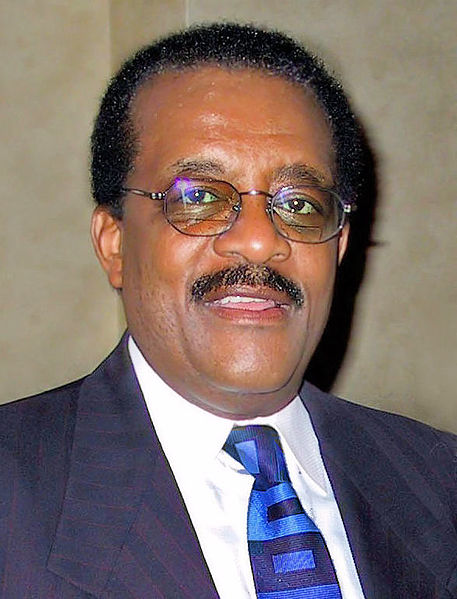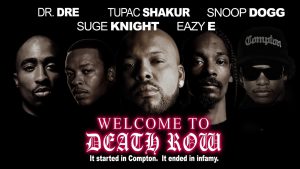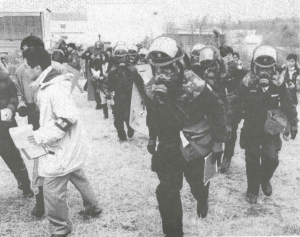In 1996, Elmer “Geronimo” Pratt’s petition for a writ of habeas corpus had finally been granted. It was a very long twenty-seven-year journey that Pratt and his lawyer, Johnnie Cochran, endured. Pratt continued to state his innocence to the crime. His lawyer Cochran wholeheartedly still believed him, and would defend him for yet a second time. Pratt’s appeal asserted three significant claims: his alibi; claims that two different men were known to commit the crime; and the false information that the law enforcement gave in court.1 Pratt previously had two unsuccessful petitions for a writ of habeas corpus. In Pratt’s court case for his murder trial of 1972, he had been deprived of evidence that would have been beneficial in his case for determining whether he really would have been convicted for the twenty-seven years he had already served. Pratt had been charged with murder in the first degree, two counts of robbery, and assault with the intent to commit murder.2

Lawyer Johnnie Cochran built his practice in California, where his family moved to when he was younger.3 Cochran was inspired by Thurgood Marshall in his handling of the Brown v. Board of Education case. It led him to pursue a career in law. Marshall’s decision affirmed the rights of students in the American school system that “separate but equal” school segregation was unconstitutional. Cochran admired what Marshall did, seeing Marshall as a model. His practice built him up to have a well-known reputation in the African-American community as a lawyer who defended against police brutality cases, even representing famous people such as Micheal Jackson and O.J. Simpson. One afternoon well into his career, he was driving his two young daughters at the time in his Rolls Royce. The police pulled him over, yelling at him to get out of the vehicle, and he noticed that they had their guns drawn. The police officers then proceeded to search his car, and they came across his badge from the District Attorney’s office. The officers were very apologetic, but Cochran was concerned about the effect that this event might have on his daughters. He did not want his daughters to think that he got pulled over because of the color of their skin and the car he was driving. Instead, he decided that he was going to try and make things better for African Americans.4
In August 1972, Johnnie Cochran took up Pratt’s case (People v. Pratt) for the murder of Caroline Olsen and for assault with the intent to murder her husband, Kenneth Olsen. Pratt was identified as a member of the Black Panther Party. At the beginning of the investigation, Pratt had not been a prime suspect. That changed when a letter that Julius Butler gave to Police Sergeant DuWayne Rice was opened, which revealed the specific crimes that Pratt had supposedly committed. When Rice was put on the stand, he testified that Butler had been his unpaid informant for approximately a week before he received that letter from him. Butler had once been a deputy sheriff for the Los Angeles County Police. He had resigned from the force, ran a beauty salon, and then soon afterward, joined the Black Panther Party (BPP). Butler testified in court that Pratt had committed the crimes from the conversation that Pratt had with him stating the crimes he committed. On cross-examination, Butler testified that he was neither working for the BPP, nor for law enforcement when he gave Rice the letter.5
Mrs. Reed of Reed’s Hobby Shop, near the scene of the crime, was a prime eyewitness to the crime. She stated that she saw two African-American men enter the store. They gave her an uneasy feeling, so she locked the store door. Kenneth and Caroline Olsen were at the Santa Monica park playing tennis when they were directed by two men to surrender their belongings. Those two men then proceeded to open fire, killing Caroline Olsen with two gunshots and leaving Kenneth Olsen wounded with five shots.6 At the trial, Mrs. Reed identified Pratt as one of the men who had entered the store, and Mr. Olsen identified him as one of the men during the incident. Mitchell Lackman, who was near the tennis courts when the event occurred, saw two male African Americans get into a red car with a white canvas top. The evidence from eyewitness identification, circumstantial evidence, and the testimony from Julius Butler all contributed evidence that Pratt had taken part in the shooting.7
In the defense’s testimony, Pratt was registered as the owner of the car that fit the description that Lackman described as leaving the crime scene, but he referred to it as a “community car.” Many members of the BPP, including Julius Butler, had driven this car before seeing the significance that this car had. The seizure of the gun that was discovered in a raid was an indirect result of finding the same weapon used in the shooting of the Olsen’s. This raid was done on a local house owned by the BPP community. Testing was done to see if the casings and the extractor matched the gun that was used at the Olsens’ crime scene. Both matched, but when the weapon was tested, the slug could not be matched, leading to speculation that the barrel of the gun had been changed or it may have been used many times. Pratt argued that the gun that was found in the house could have been used by anyone. He had never even entered the house from which the firearm was seized.8
Elmer Pratt was found guilty of all charges, and that led him to be imprisoned for twenty-seven years. During those years, Cochran and Pratt continued to fight to overturn his murder conviction and get him released. It was finally evident that Pratt had been framed, and critical documents that corresponded with the FBI had been withheld from the court. Julius Butler was a star eyewitness for writing a letter stating that he had heard Pratt confess to committing the Santa Monica shootings. Butler denied at the original trial that he was not an informant for the FBI, but not only was he an informant for the FBI, but also for the LAPD and for LA district attorney as well. Cochran was able to get Butler to admit to it on the stand. He asked Butler to give him a definition of an “informant,” then Cochran proceeded to ask him if, by his definition, he was an informant. Butler admitted to being one, making this one of the overturning moments in the trial. The FBI concealed evidence of Pratt’s alibi. They knew he was in the San Francisco Bay area at the time of the incident, but when Cochran requested to see the logs that supported this information, they happened to be missing. A retired twenty-five-year veteran FBI agent who had been a part of the force at the time released this information to Cochran. He recalled another fellow agent, who had already been watching over Pratt, declare that he was in Oakland at the time of the shooting. He then went on to say that there had been wiretaps installed at the BPP headquarters, and there was no information on the results of this action. Pratt’s civil rights were violated in many different ways. He was denied a fair trial with all the crucial information that was left out of the original court case. These major claims allowed for Pratt to be granted a new trial under his petition for a writ of habeas corpus.9

On March 13, 1997, Judge Dickey was presented evidence making it clear that Butler had been informing law enforcement of the Black Panther Party at least three years before the trial. This information was crucial regarding Butler’s credibility in testifying about the other vital aspects of the trial. Judge Dickey then cited evidence that included the Los Angeles District Attorney, listing Butler as a confidential informant in 1972. None of this information, now disclosed, had been available to Pratt’s defense counsel, but had been available to the District Attorney from its own office, the Los Angeles Police Department, and the FBI records. In the case of Brady v. Maryland, it was concluded that evidence is material only if there is a reasonable probability that, had it been disclosed to the defense, the result would have been different. Evidence is favorable if it helps the defendant or hurts the prosecution, as by impeaching one of its witnesses. The results of this is not whether the defendant would have received a different verdict than what was initially granted, but whether the defendant received a fair trial. Elmer Pratt was then released on June 10, 1997. In February of 1999, the court dismissed his charges and he won a federal civil right lawsuit for wrongful imprisonment.10
Cochran believed justice was not always served in the legal system, and much of it was due to racism. Cochran was relieved that after twenty-seven years of being imprisoned, Pratt was able to gain his freedom again. He used the defeat from Pratt’s original case as the motive for obtaining justice for his defendant. Cochran believed that if the state of California would have had the death penalty in 1972, Pratt would have been assigned it. Fortunately, there was a moratorium at the time prohibiting the death penalty. Cochran said, “In this country, you have to be willing to fight and preserve what you believe in” during an interview with CNN.11 Cochran truly loved his vocation and being able to practice law across the United States. He took this case’s victory to heart. It had great significance to Cochran, knowing this court case started when he was a young lawyer and followed throughout his career.

- Roy Nakano, The Case of Elmer Geronimo Pratt: A Long and Winding Road to Retrial (California, California Digital Library, 1985), 196-197. ↵
- “In Re Pratt,” December 1980, Justia US Law. ↵
- “Legal Legends,” 2012, The Cochran Firm. ↵
- Johnnie Cochran and David Fisher, A Lawyer’s Life (New York: Thomas Dunne Books), 2. ↵
- “In Re Pratt,” December 1980, Justia US Law. ↵
- Roy Nakano, The Case of Elmer Geronimo Pratt: A Long and Winding Road to Retrial (University of California, 1985), 2. ↵
- “In Re Pratt,” December 1980, Justia US Law. ↵
- “In Re Pratt,” December 1980, Justia US Law. ↵
- Roy Nakano, The Case of Elmer Geronimo Pratt: A Long and Winding Road to Retrial (California, California Digital Library, 1985), 194. ↵
- “In Re Pratt,” December 1980, Justia US Law. ↵
- Johnnie Cochran, interview by Greta Van Susteren, CNN, last modified in 2001. ↵



27 comments
Makayla Soto
This whole article was super interesting and informative to read! You provide great background knowledge to set us at the scene of the article. This is another article well written about injustice for people of color and bringing awareness and educating others. I never knew about this case until now and it should be used in today’s world for bettering our justice teams!
Perla Ramirez
The justice system is supposed to protect but it simply does the opposite. It does more injustices than justice to people of color. There is some stories that never see the light of day but there is a few that do and those are the one that make the change. Much like in the article above it screams racial injustice. He worked his whole life to proof his innocence but he doesn’t stand a chance.
Angela Perez
It is disheartening to read an article of yet another black man fallen victim of the justice system in this country. I really liked that this article focused on the facts of the case and really emphasized the lack of solid evidence against Pratt. Cochran’s has obviously defended a wide variety of defendants, but it is inspiring that he stuck by his client for twenty-seven years to ensure that he got justice.
Eric Grant
This is an interesting story that paints Johnnie Cochran in a different picture than what I knew about him. I had always thought of Cochran as a man who willingly defended O.J Simpson (a murderer). From this article, I learned what a petition for Habeas Corpus was, and an archetypal scenario that shows why we need it. This is truly great work!
Donte Joseph
Before reading this article, I did not know of Johnnie Coachran and the People vs Pratt. It is sad that while long cases are wrong, they do happen. Sometimes the wrong person is pinned just to close a case, and other times it could be an honest error. No matter the case, I think that going as far as 27 years is something that should not happen. I understand that there are other factors that go into setting someone free but 27 years is majority of a persons life depending on when they are sentenced.
Kayla Sultemeier
It is so unfortunate that so many people think that our criminal justice system is entirely fair. This is only one example of how biased of a system we participate in. I have honestly never heard of anything pertaining to Johnie Cochran’s role in our criminal justice system aside from the OJ Simpson case. It also stood out to me when you mentioned how he got pulled over simply because he is a black man who had a nice car. Unfortunately these occurrences are normalized. The police should receive much better training as well as undergo much deeper psychological testing in order to be qualified for their jobs. They are more oppressive than they are protective.
Victor Rodriguez
It is very sad to see so many examples like Johnnie Cochran. Our criminal justice system is broken in many ways and definitely needs fixing. How many more innocent people are going to get abused and deprived for living a free life. There is no doubt that the criminal justice system needs reform. I believe that there needs to be changes made in order to replace the harsh policies and all the racial discrimination that exists. We need better social justice for everyone. I know that the United States hold a very high incarceration rate and we need to figure why that is. Furthermore, the trials must be more fair and faster that way innocent people do not spend a long time in prison.
Alexa Montelongo
It’s really interesting and sad to read a lot of the cases that have been reopened or that have had not had the opportunity to be reopened. Cases like this shed light on the systemic racism and racial profiling in our justice system and not only highlight that there must be a reform, but accentuates the number of cases that have been dismissed like this. If this case took 27 years for him to be freed, then how many other cases are also taking this long to be opened again to even be considered for parole? one of the many reasons why I would love to be a lawyer and a politician is to open cases like these and reform our criminal justice system.
Aracely Beltran
Oh my gosh, just reading the title I just knew I had to read this. Which by the way is a very well written article. Thank you for sharing Cochran’s story with us who had no idea about this. 27 years is longer than I have been alive, I cannot imagine his frustration and anger. I know I would not be able to do it.
Sofia Almanzan
I really enjoyed this article because it points out the problems in the justice system. I had never heard of this case before reading this article but I have heard of many like it. I did find it interesting that this particular case had the FBI involved with an informant.
Mia Hernandez
Before reading this article, I had not heard about the People vs Pratt case or about Johnnie Cochran, but this article allowed me to get some insight and information on both. I cannot begin to imagine what it would have been like to serve 27 years in prison for a crime that you did not take part in.